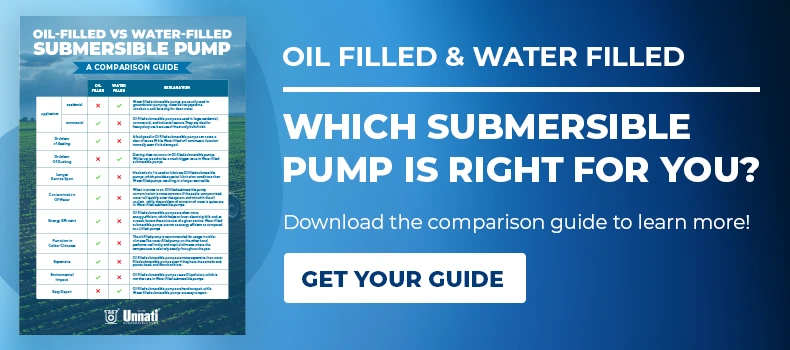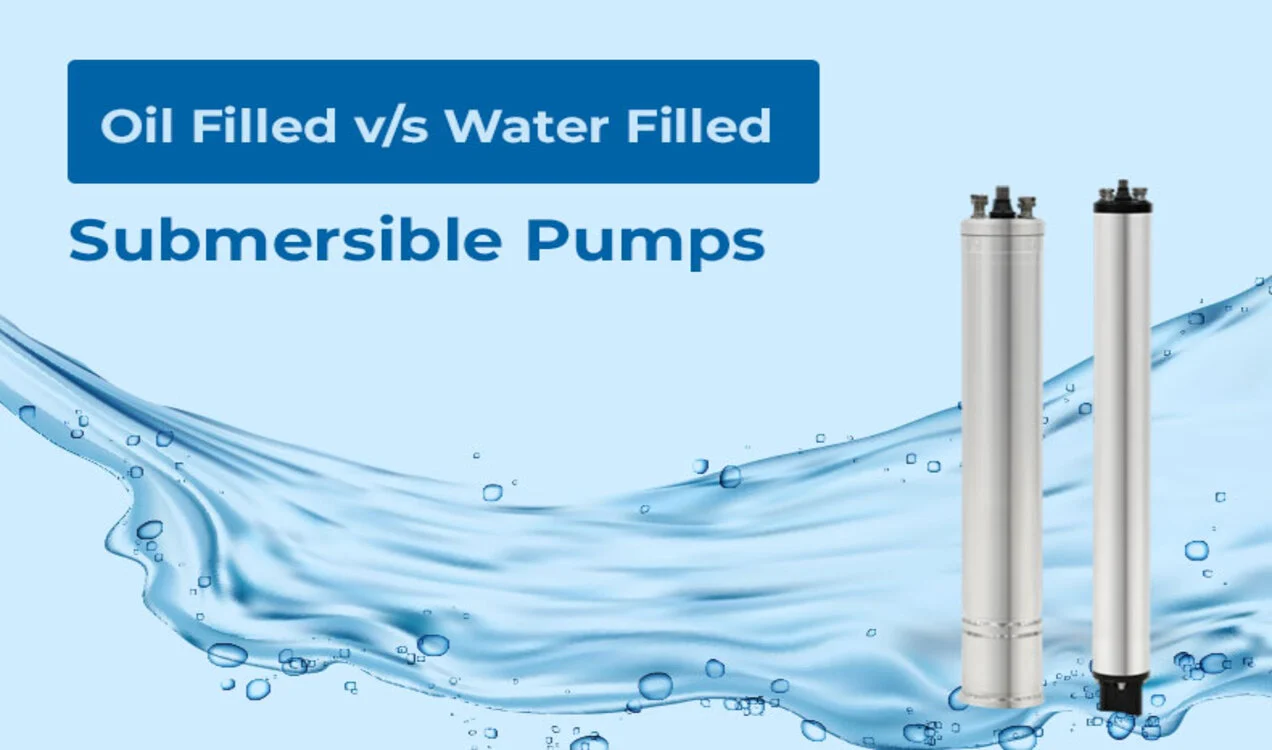Manufacturers have long debated about which submersible pump to choose: oil or water?
The motor cooling method of a water-filled submersible pump is filled with water, whereas the motor cooling method of an oil-filled submersible pump is filled with mechanical oil, both of which have excellent cooling capabilities and are resistant to water.
But both have different use cases, features, advantages, and disadvantages, keep reading to know more.

Comparison of Oil Filled V/s Water Filled Submersible Pumps
Difference Between Water & Oil Filled Submersible Pumps:
Due to the fact that submersible pumps are totally immersed underground under the water, the motor cooling method is often liquid rather than air. The pumps are available in two sorts of models based on this idea.
The first uses water as a coolant, whereas the second uses oil as a coolant. Submersible pumps that we fill with water or oil are usually more efficient in safeguarding motors.
Depending on the intended use, each of these categories has its own set of features and characteristics.
Application Of Water & Oil Filled Submersible Pump:
Oil filled submersible pumps consist of machinery oil, and the applications for both oil-filled and water-filled submersible pumps are distinct.
Water towers, water distribution, flood protection and drainage, and municipal construction drainage are all common uses for these types of submersible pumps.
The structure of the water-filled submersible pump is light and compact. It is thought to be excellent for small home needs and consumption.
Water filled submersible pumps, on the other hand, are utilised in groundwater pumping, water delivery systems, circulation, and boosting for clean water. It contains ordinary water.
The oil-filled submersible pump is preferred in the large residential, commercial, and industrial sectors. It’s ideal for heavy-duty use because of the sturdy built-finish.
Electrical Winding System:
The electrical winding system is critical in allowing the device to run on electricity. To keep water out of a submersible pump that is filled with water, a PVC insulated wire is employed. Even if a short circuit occurs, you can simply repair the PVC wire without difficulty.
A copper plated wire used in the oil-filled submersible pump ensures smooth and trouble-free operation. If a short-circuit occurs in the copper wire in this type of submersible pump, restoring the damage is difficult and time-consuming.
Sealing Of Submersible Pump:
To minimise serious malfunctions in submersible pumps, you should do the sealing strongly and correctly. But in the case of the water-filled submersible pump, it will continue to function normally even if it is damaged. This is because of the waterproof nature of the PVC wiring.
When it comes to oil-filled submersible pumps, though, a faulty seal can cause a slew of issues. When water enters, it immediately causes oil leakage and damages the ball-bearing, causing the operation to stop. If the wire enameling is weak, it can potentially produce a short-circuit.
Problem Of Rusting In Submersible Pumps:
Rusting is most commonly linked with a submersible pump that is flooded with water. Because water is the coolant in these pumps, if they are not utilised for an extended period of time, they are likely to rust within the pump. Even if power is applied to the motor, it will not operate. As a result, rust is said to be a much bigger issue in water-filled submersible pumps.
Because you are utilising oil as a coolant, rusting does not occur in an oil-filled pump. Even if the motor is not used for a long period, it will provide smooth service. Rusting or motor operations, even after a lengthy period of time, are not an issue.
Service Span:
Mechanical oil is used to lubricate oil-filled submersible pumps, which provide superior lubrication conditions than water-filled pumps, resulting in a longer service life. It’s also self-lubricating, which makes the procedure manual and improves the pump’s quality and lifespan.
On the contrary, Water-filled submersible pumps have a lower service life than oil-filled submersible pumps because they are not self-lubricated and require maintenance.
Bearing Mechanism:
The bearing mechanism in the motors decreases friction between the rotating shafts. We commonly see Bush bearings in submersible pumps that are filled with water. When water circulates, these are separate plain bearings that provide bearing surfaces for rotating applications.
The ball bearing carries the actions of the oil-filled submersible pumps. Oil functions as a lubricant for the ball, allowing it to support axial and radial loads while also reducing friction.
Contamination Of Water In Submersible Pumps:
Contamination of water is a common issue with submersible pumps. The problem of corrosion of water is quite rare with water-filled pumps, even if water leaks through the seal.
Contamination will occur in water-filled submersible pumps only if any chemical is coupled with the water.
When it comes to an oil-filled submersible pump, however, contamination is more common. If the seal is compromised, water will quickly enter the system and mix with the oil coolant. All of these raise the likelihood of oil contaminating the water.
Energy efficient:
Another factor that distinguishes between oil-filled and water-filled submersible pumps is energy efficiency. Oil-filled pumps are often more energy-efficient, which helps to lower electricity bills and, as a result, lowers the entire cost of a given service.
Water-filled pumps are not as energy efficient as compared to oil-filled pumps, which results in higher electricity bills and expenses.
Use case according to the regions & temperature:
Another significant distinction exists between the two types of submersible pumps is use according to regions. The oil-filled pump is recommended for usage in colder climates. The oil coolant does not easily freeze, even when the temperature rises above the freezing point.
The water-filled pump, on the other hand, performs well in dry and tropical climates where the temperature is relatively steady throughout the year. So as per your requirements & temperature of the place, you can choose the best one suited to your needs.
Pricing of submersible pumps:
Oil-filled submersible pumps are more expensive than water-filled submersible pumps even if they have the same brand, power, head, and flow conditions.
Wrapping up!
So, here’s everything you should know about water as well as Oil filled submersible pumps. Each one has its different set of requirements, use cases, advantages, disadvantages and features. So, you can choose as per your requirements and results needed.
You have to make a wise choice when deciding to get the best of results. Above all, whether it’s a water-filled or oil-filled pump, you should opt for high-quality and best submersible pumps.
We hope this article is helpful to you and if you have any questions about it, you can freely ask us in the comment section below.
Are you Planning to Purchase a Submersible Pump and need more information Visit our website Unnati Pumps.
You can also read: Submersible Pump v/s Centrifugal Pump


